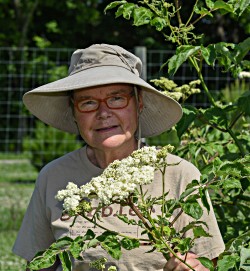
UMES Extension Specialty Herbs Consultant Henriette den Ouden grows 18 different medicinal and culinary herbs at the UMES Research and Demonstration Farm at 10789 Stewart Neck Road just south of campus in Princess Anne, Maryland. The herb garden is a place for farmers and home gardeners to see the herbs, taste and smell them and learn how to grow them. Den Ouden is developing the best growing methods for farmers in Maryland; and teaches farmers how and when to grow, harvest and process the herbs commercially. For more information, or to visit, please email hdenouden@umes.edu or call 410 621 5450, extension 104.
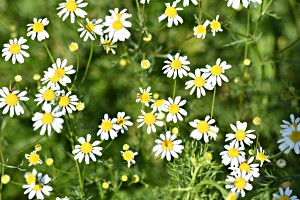
Chamomile (Matricaria recutita)
Use: Very popular tea plant used for rest and stomach upset. Traditional folk medicine for thousands of years used to calm anxiety, help with sleep and settle stomachs. Very safe for children.
Part used and how: Flowers used in tea or as tincture. Sometimes used in soap and oil.
Origin: Traditional European herb
Growing: Grow from seeds by direct seeding in the fall or very early spring, or plant seeds in plugs in a cold frame and transfer in April. Needs full sun, grows in almost any kind of soil. Harvest in May and June before it gets too warm. Harvest is labor intensive and needs to be done frequently. Nice herb for small herb gardens and family use.
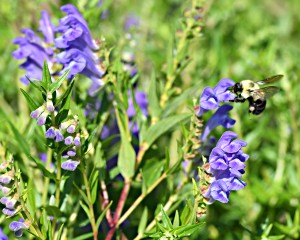
Baikal skullcap (Scutellaria baicalensis) (Huang qin)
Use: Traditionally used in Chinese medicine to what it calls “clear heat.” This basically means relieve inflammation. Currently, it is frequently used in Western medicine for inflammation and is researched for use for cancer.
Part used and how: The root (that is beautiful bright yellow). Harvest in the fall after three years of growth. The root needs to be processed following traditional Chinese guidelines if sold for Chinese medicine. This plant is a gorgeous addition to any herb garden with the beautiful dark blue flowers that stay for most of the summer.
Origin: China

Coneflower (Echinacea purpurea)
Use: Traditionally used as a preventative for colds. It is a popular herb that has gained popularity as it is said to build the immune system. Also used topically for animal bites. People with auto immune disease should be careful with using this herb.
Part used and how: Roots after third growing season are preferred. Roots sold fresh or dried. Flowers and leaves are used in teas and tinctures. Make sure when buying seeds or plants to buy the native, non-cultivar plant.
Origin: Mid and Eastern U.S.
Growing: Plant seeds early spring or during the winter. Use deep plugs and transplant if roots grow out. Transplant outside early spring, 1.5 foot distance. Will spread. Division of roots is also used. Seeds can also be direct seeded.
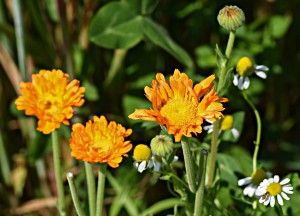
Calendula (Calendula officinalis)
Use: Mostly known for its use in oils and creams, but can also be used internally as tea or tincture. It has a healing effect on surface wounds and scars. Also known to be anti-fungal.
Part used and how: Only the flowers are used. After drying they are made into an infused oil: add olive oil (or other quality oil) to a glass container with the dried flowers and leave in the sun for several weeks.
Origin: Europe, but grown everywhere.
Growing: Can be direct seeded early spring around the last day of frost, or planted in a cold frame and transferred after the last frost. Flowers throughout the summer, but main harvest is before August. Sometimes comes back in the fall. Very nice herb for gardens and for children. Makes any garden look happy.
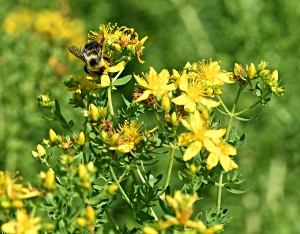
St John’s wort (Hypericum perforatum)
Use: Became popular for its anti-depressant effect. Wound and burn-wound healer when used as oil. Oil is a beautiful red. Used in a tincture or as a capsule it can help for pain. It interacts with pharmaceuticals and can lead to sunburn if used internally. Do not grow where horses live, as it weakens their legs.
Part used and how: Use the flower buds, young flowers and top leaves. Best used fresh for infused oil and tincture. Used dried for tea. The flower bud should leave a red oil when rolled between your fingers.
Origin: Europe
Growing: The native variety is hard to establish. Seed them in several places. The cultivars can be seeded in flats in late winter and transplanted when about two inches high. Protect from weeds in the beginning growing phase. This perennial flowers in second and following years. This plant can also be found as a wild plant on the Eastern Shore. (Never pick it all)
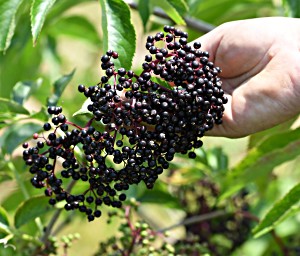
Elderberry (Sambucus nigra and Sambucus canadensis)
Use: Traditional plant whose dark purple berries have been used for inflammation and as a preventative immune builder. Has become extremely popular over the past two years. Also popular as wine, jelly and elder syrup. Keep in mind that the seeds are not edible. The flower is used in teas as a sweetener. In Eastern Europe the flower heads are fried and eaten.
Part used and how: Flower and berries used for syrup and in teas. Berries used for medicine and wine. The bush itself is often seen as a mythical presence in the garden to protect from dangers. Many stories have been written and can be told.
Origin: Europe (nigra), U.S. (canadensis)
Growing: Buy cuttings after studying which variety fits your situation best. Make sure to have two cultivars, or use the native. Moist and rich soil is required, water frequently and protect from weeds. Cultivars often can be cut down after each growing season. The natives should be thinned out every year, but never be cut down.
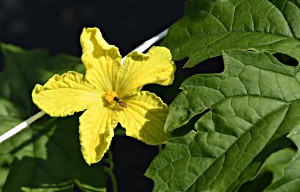
Bitter Melon (Momordica charantia)
Use: Traditional Asian food. The bitter taste doesn’t make it a popular herb for Americans, although the health benefits convince some people to eat it. It is known to lower blood sugar in people with pre-diabetes. It is extremely easy to digest, low in calories and rich in vitamin C. There are very nice recipes available if you want to try it.
Part used and how: Fruit that resembles a prickly squash is used as food, can be eaten raw or cooked. Traditional Asian food with a bitter taste. Fruit and seeds used dried in capsules or fresh in tincture.
Origin: Asia
Growing: Plant seeds when soil has warmed up in rows or hills. This becomes a very dense running plant, limit to two or three seeds on a hill or one to two feet apart. Requires direct sun, fertile soil, regular watering and weeding. Grow on trellises for easier harvest. Maturation takes 100 days. Pick the fruits before they feel hollow or/and start turning red.
Gail Stephens, agricultural communications, University of Maryland Eastern Shore, School of Agricultural and Natural Sciences, gcstephens@umes.edu, 410-621-3850.
Photos by Todd Dudek, agricultural communications photographer/videographer, UMES School of Agricultural and Natural Sciences, tdudek@umes.edu.

